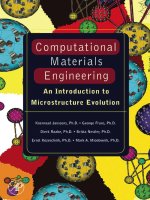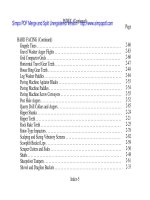NAVFAC P-433 Welding Materials Handbook_1 pot
Bạn đang xem bản rút gọn của tài liệu. Xem và tải ngay bản đầy đủ của tài liệu tại đây (92.84 KB, 17 trang )
FIGURES (Continued)
Figure No.
Title
Page
2-41
2-42
2-43
2-44
2-45
2-46
2-47
2-48
2-49
2-50
2-51
2-52
2-53
2-54
2-55
2-56
2-57
2-58
2-59
2-60
2-61
Hard-Facing Ditcher Rolls . . . . . . . . . . . . . . . . . . . . . . . . . . . . . . . . . . . . . . . .
Hard-Facing Ditcher Drive Sprockets . . . . . . . . . . . . . . . . . . . . . . . . . . . . . . .
Hard-Facing Ditcher Teeth . . . . . . . . . . . . . . . . . . . . . . . . . . . . . . . . . . . . . . .
Hard-Facing Post Hole Augers. . . . . . . . . . . . . . . . . . . . . . . . . . . . . . . . . . . .
Hard-Facing Asphalt Mixer Paddles . . . . . . . . . . . . . . . . . . . . . . . . . . . . . . . .
Hard-Facing Asphalt Mixer Paddle Shanks . . . . . . . . . . . . . . . . . . . . . . . . . . .
Hard-Facing Paving Machine Paddles . . . . . . . . . . . . . . . . . . . . . . . . . . . . . .
Hard-Facing Paving Machine Agitator Blades . . . . . . . . . . . . . . . . . . . . . . . .
Hard-Facing Paving Machine Screw Conveyors . . . . . . . . . . . . . . . . . . . . . . .
Hard-Facing Scraper Cutters and Sides . . . . . . . . . . . . . . . . . . . . . . . . . . . . . .
Hard-Facing Asphalt Mixer Scraper Blades . . . . . . . . . . . . . . . . . . . . . . . . . .
Hard-Facing Grader Blades . . . . . . . . . . . . . . . . . . . . . . . . . . . . . . . . . . . . . . .
Hard-Facing Grader End Bits . . . . . . . . . . . . . . . . . . . . . . . . . . . . . . . . . . . . . .
Hard-Facing Scooplift Bucket Lips . . . . . . . . . . . . . . . . . . . . . . . . . . . . . . . . .
Hard-Facing Grapple Tines . . . . . . . . . . . . . . . . . . . . . . . . . . . . . . . . . . . . . . .
Hard-Facing Grid Compactor Grids . . . . . . . . . . . . . . . . . . . . . . . . . . . . . . . . .
Hard-Facing Sheepsfoot Tampers . . . . . . . . . . . . . . . . . . . . . . . . . . . . . . . . . . .
Hard-Facing Curbing Machine Augers . . . . . . . . . . . . . . . . . . . . . . . . . . . . . .
Hard-Facing Backhoe Sidecutters . . . . . . . . . . . . . . . . . . . . . . . . . . . . . . . . . .
Hard-Facing Trencher Teeth . . . . . . . . . . . . . . . . . . . . . . . . . . . . . . . . . . . . . .
Hard-Facing Shredding Hammers . . . . . . . . . . . . . . . . . . . . . . . . . . . . . . . . . .
2-50
2-51
2-51
2-52
2-53
2-54
2-54
2-55
2-55
2-56
2-57
2-58
2-59
2-59
2-60
2-60
2-62
2-63
2-64
2-65
2-66
xxi
Simpo PDF Merge and Split Unregistered Version -
FIGURES (Continued)
Figure No.
Title
Page
2-62
2-63
2-64
2-65
2-66
2-67
2-68
2-69
2-70
2-71
2-72
2-73
2-74
2-75
2-76
2-77
4-1
4-2
4-3
4-4
4-5
Wear Measurement of Crusher Roll Shells . . . . . . . . . . . . . . . . . . . . . . . . . . .
Preventing Warpage of Crusher Roll Shells . . . . . . . . . . . . . . . . . . . . . . . . . . .
Welding Limits on Crusher Roll Shells . . . . . . . . . . . . . . . . . . . . . . . . . . . . . .
Insufficient and Proper Stepover Techniques Examples . . . . . . . . . . . . . . . . .
Rebuilding Procedure for Crusher Roll Shells . . . . . . . . . . . . . . . . . . . . . . . .
Hard-Facing Crusher Roll Shells. . . . . . . . . . . . . . . . . . . . . . . . . . . . . . . . . . .
Crusher Roll Shell Rebuilding Technique . . . . . . . . . . . . . . . . . . . . . . . . . . . .
Repairing Cracked Manganese Crusher Rolls . . . . . . . . . . . . . . . . . . . . . . . . .
Hard-Facing Rotor-Type Impactors . . . . . . . . . . . . . . . . . . . . . . . . . . . . . . . . .
Rebuilding and Hard-Facing Crusher Jaws . . . . . . . . . . . . . . . . . . . . . . . . . . .
Restoring Worn Areas on Wobbler Feeders . . . . . . . . . . . . . . . . . . . . . . . . . . .
Hard-Facing Scalping and Sizing Vibratory Screens . . . . . . . . . . . . . . . . . . .
Hard-Facing Gravel Washer Auger Flight . . . . . . . . . . . . . . . . . . . . . . . . . . .
Hard-Facing Log Washer Paddles . . . . . . . . . . . . . . . . . . . . . . . . . . . . . . . . . .
Hard-Facing Elevator Bucket Lips . . . . . . . . . . . . . . . . . . . . . . . . . . . . . . . . .
Hard-Facing Quarry Drill Collars and Augers . . . . . . . . . . . . . . . . . . . . . . . . .
MAPP Gas Torch Tip Design . . . . . . . . . . . . . . . . . . . . . . . . . . . . . . . . . . . . . .
Preheat Flame Characteristics . . . . . . . . . . . . . . . . . . . . . . . . . . . . . . . . . . . .
Correct Measurement of Coupling Distance . . . . . . . . . . . . . . . . . . . . . . . . . . .
Correct Torch Angles . . . . . . . . . . . . . . . . . . . . . . . . . . . . . . . . . . . . . . . . . . . .
MAPP Gas and Compressed Air Burner . . . . . . . . . . . . . . . . . . . . . . . . . . . . .
2-67
2-69
2-70
2-71
2-74
2-75
2-75
2-77
2-78
2-81
2-82
2-83
2-83
2-84
2-84
2-85
4-5
4-14
4-16
4-18
4-26
xxii
Simpo PDF Merge and Split Unregistered Version -
TABLES
Table No.
Title
Page
1-1
1-2
1-3
1-4
1-5
1-6
2 - 1
4 - 1
4-2
4-3
4-4
Cast Iron Application Guide . . . . . . . . . . . . . . . . . . . . . . . . . . . . . . . . . . . . . . .
Copper, Brass, and Bronze Application Guide . . . . . . . . . . . . . . . . . . . . . . . . .
Aluminum Application Guide . . . . . . . . . . . . . . . . . . . . . . . . . . . . . . . . . . . . .
Stainless Steel Application Guide . . . . . . . . . . . . . . . . . . . . . . . . . . . . . . . .
Steel Application Guide . . . . . . . . . . . . . . . . . . . . . . . . . . . . . . . . . . . . . . . . . .
Welding Rod Comparison Chart. . . . . . . . . . . . . . . . . . . . . . . . . . . . . . . . . .
Metals Preheating Chart . . . . . . . . . . . . . . . . . . . . . . . . . . . . . . . . . . . . . . . . . .
Welding Tip Size and Application Using MAPP Gas . . . . . . . . . . . . . . . . . . .
Welding Tip Counterbore Schedule . . . . . . . . . . . . . . . . . . . . . . . . . . . . . . . . .
Oxy-Fuel Ratios/Flame Condition Comparisons . . . . . . . . . . . . . . . . . . . . . . .
Hadfield’s Manganese Steel Cutting Conditions . . . . . . . . . . . . . . . . . . . . . . .
1-35
1-37
1-39
1-40
1-42
1-45
2-6
4-6
4-8
4-12
4-23
xxiii
Simpo PDF Merge and Split Unregistered Version -
Section 1. WELDING MATERIALS
USES, PROCEDURES, AND CHARACTERISTICS
TYPE: MILD STEEL - ARC AWS/ASTM E-601 1
NSN: 9GD 3439-00-165-4173 (1/8X 14)
9GD 3439-00-165-4185 (5/32x 14)
9GD 3439-00-262-2655 (3/16X 14)
POSITION: All
POLARITY: AC or DC Straight or Reverse
RECOMMENDED AMPERAGES:
1/8 - 80 to 130
5/32 -130 to 160
USES:
Primary:
Joining of mild steel.
Secondary: Good for galvanized steel. Substitute
for cutting rod; soak coating and use on straight
polarity. On sheet metal, use straight polarity for a
forceful spray arc.
PROCEDURES:
Flat: Very short arc.
Stay ahead of puddle and use
a slight w-hipping motion.
Vertical: Start at the bottom and go to the top using
a slight whipping motion. When welding from top to
bottom, don’t use any motion.
Overhead: Use same technique as the vertical
bottom to top. Multipass for buildup.
CHARACTERISTICS :
Deep penetration, light slag, fast freezing deposit.
Tensile Strength: 62,000-72,000 psig
1-1
Simpo PDF Merge and Split Unregistered Version -
TYPE: MILD STEEL - ARC AWS/ASTM E-6012
NSN: 9GD 3439-00-947-5383 (3/32X 14)
9GD 3439-00-165-4176 (1/8X 14)
9GD 3439-00-165-4175 (5/32x 14)
POSITIONS: All
POLARITY: AC or DC Straight
RECOMMENDED AMPERAGES:
3/32 - 40 to 90
1/8 - 80 to 120
5/32 -120 to 190
USES:
Primary: Joining of mild steel. Small-diameter rods
for sheet metal, large-diameter rods for fillets and poor
fit-up.
Secondary: A fast electrode for overlaying and
cladding of worn and undercut surfaces prior to
wearfacing.
PROCEDURES:
On flat butt joints, hold the rod at a right angle to the
plate. On horizontal fillets, the rod is held 30 to 45
degrees with horizontal and at a right angle to the
longitudinal axis. Weld vertical from top down. Use a
whipping motion when welding from bottom to top.
For overhead work, use a slight whipping motion.
CHARACTERISTICS :
Shallow to medium penetration, medium heavy slag,
smooth bead, low spatter loss. Excellent for rusty
metal.
Tensile Strength: 67,000-80,000 psig
1-2
Simpo PDF Merge and Split Unregistered Version -
TYPE: STEEL - ARC (low alloy or mild)
AWS/ASTM E-7018
NSN: 9GD 3439-00-165-4186 (1/8X 14)
9GD 3439-00-479-1099 (5/32X 14)
9GD 3439-00-853-2719 (3/16X 14)
POSITION: All
POLARITY: AC or DC Reverse
RECOMMENDED AMPERAGES:
1/8 -100 to 150
5/32 -120 to 200
USES:
Primary: Excellent for joining low-alloy structural
steels such as Cor-Ten, Mayari R, Lukens 45 and 50,
or Yoloy. Use for welding well casings.
Secondary: Joining all mild steels. Buildup prior to
wearfacing.
PROCEDURES: Hold a short arc and use a slight
weave.
Flat: Use a high side of current range - weave up to
1-3
2 1/2 times diameter of rod.
Vertical: Make root pass with a straight upward
progression and a short arc Some welders prefer a
V shape motion for root passes. Hesitate at point of
the “V” in the root to assure penetration. Each leg of
the “V” should be about 1/8 in. No whipping should
be done. On subsequent passes, weave across the face
of the root, continuously building up a shelf. The
weave should pause at the sides of the first pass to
clear out trapped slag.
Overhead: Use only stringer beads. Fillets should
be made with electrode at a 30 degree angle off the
vertical leg.
Horizontal: Use stringer beads for fillets; direct rod
into joint at a 45 degree angle. On subsequent passes,
use only stringer beads.
CHARACTERISTICS:
Soft arc, low spatter, good bead contour and wetting
actions, produces highest quality X-ray deposits. Good
impact resistance at normal and sub-zero
temperatures. Excellent for high-sulfur (free
machining) steels, and cold rolled steels.
Tensile Strength: 70,000-78,000 psig
Simpo PDF Merge and Split Unregistered Version -
TYPE: STEEL - ARC (low-alloy, high-strength
steels) AWS/ASTM E-11018
NSN: 9GD 3439-00-165-4167 (1/8X 14)
9GD 3439-00-165-4165 (5/32X 14)
POSITION: All
POLARITY: AC or DC Reverse
RECOMMENDED AMPERAGES:
1/8 - ll0 to 150
5/32 -120 to 200
USES:
Primary: Joining of low-allow, high-strength steels
such as T-1, HY-80, HY-90, HY-100, SSS100 and
Jalloy 90 and 100.
Secondary: Substitute for buildup for wearfacing.
(NOTE: This rod is prefened over mild steel
electrodes for wearfacing buildup.)
PROCEDURES:
Hold a short arc and use a slight weave.
Flat: Use high side of current range; weave up to 2
1/2 times diameter of rod.
Vertical: Make root pass with a straight upward
progression -
short arc. Some welders prefer a “V”
shape motion for root passes. Hesitate at “V” point in
the root to assure penetration. Each “V” leg should be
about 1/8 inch. Do not use whipping motion. On
subsequent passes, weave across the face of the root to
continuously build up a shelf. The weave should pause
at the sides of the first pass to clear out trapped slag.
Overhead: Use only stringer beads. Fillets should be
made with electrode at a 30-degree angle off the
vertical leg.
Horizontal: Use stringer beads for fillets; direct rod
into joint at a 45-degree angle. On subsequent passes.
use only stringer beads.
CHARACTERISTICS:
Fast, efficient metal transfer. Deposits have good
X-ray quality and excellent tensile and impact
properties.
Tensile Strength: 110,000-114,000 psig
1-4
Simpo PDF Merge and Split Unregistered Version -
TYPE: STEEL - GMA (low-to-medium-
carbon) AWS/ASTM E-70, S-3, or S-6
NSN: 9GD 3439-00-593-2241
(.035 X 2 1/2 lb. spool)
9GD 3439-00-903-7832
(.045 x 25 lb. roll)
POSITION: All
POLARITY: DC Reverse
WELDING DATA - ALL POSITIONS
Material
Thickness
(in.)
.037
.050
.062
.125
.187
Travel
Amps
volts Speed
(ipm)
70 17
20-40
85 18
20-50
100 18
25-35
150 20
15-25
150 20
10-20
(NOTE: The above are typical values. Specific
welding applications may require changes.)
USES:
Primary: Used for most mild steels.
Secondary: Buildup for wearfacing.
PROCEDURES:
During welding, wire stickout (tip to work distance)
should be approximately 5/16 in. Poor fit up will
require lower amps and slower speed. At 17 volts or
less, Argon-C0
2
mixtures may offer better arc
characteristics than C0
2
. Use only welding grade
C0
2
gas at a flow of 15-20 cubic feet per hour.
Mixed gas should be 75-percent argon to 25-percent
C0
2
. Use wind shield and increase flow rate in
windy conditions. This wire can be used with the
GMA Spool-On Gun.
CHARACTERISTICS:
Remember! You do not have a flux to purge the
deposited molten metal; only a shielding gas prevents
the atmosphere from coming in contact with the arc
stream. Any moisture, dirt, or oil on the base material,
welding wire, or feed rolls will cause a defective weld.
Tensile Strength: 78,000 psig
1-5
Simpo PDF Merge and Split Unregistered Version -
TYPE:
STEEL - TORCH or GTA
MISCELLANEOUS USES:
(low- and medium-carbon)
For faster buildup with arc, feed this rod into arc
stream of the electrode. If you have a wearfacing rod
NSN: 9GD 3439-00-018-1625 (1/16X 36)
that is too hard for impact, feed this rod into arc
9GD 3439-00-165-4198 (3/32X 36)
stream. If you wish to cut stainless or cast iron with
the torch, feed this rod into the kerf.
(NOTE: This triple deoxidized rod should be used if
gas welding with MAPP Gas. It can also be used with
Tensile Strength: 62,000 psig
acetylene gas.)
USES:
Gas welding or GTA welding of low- and
medium-carbon steel where properties similar to those
of the base metal are required or when the welded joint
is subjected to heat. Small parts can be fabricated
faster and with less distortion by using a brazing rod
(NSN 9GD 3439-00- 165-4199). If joint strength is
important, use NSN 9GD 3439-00-027-0953.
1-6
Simpo PDF Merge and Split Unregistered Version -
TYPE: BRAZING - TORCH
(flux-coated rod for general brazing)
NSN: 9GD 3439-00-165-4199 (1/8X 18)
9GD 3439-00-165-4197 (3/16X 18)
9GD 3439-00-252-8357 (1/4X 18)
USES:
Joining of steel and cast iron and most copper-based
metals, such as brass and bronze. Can be used on
some nickel alloys.
(NOTE: Keep base metal of nickel alloys at lowest
possible temperature.)
PROCEDURES:
Clean joint and bevel heavy sections. On cast iron, use
an excess oxygen flame to sear the weld area to a blue
heat. Preheat heavy sections to 800°F. Apply flux
to weld area and continue heating until flux melts.
Melt off a drop of the rod and flow it out - continue to
add more alloy drop by drop.
CHARACTERISTICS :
A low-fuming bronze rod that does not require fusion
of the surface of the base metal. Flux for this rod is
NSN 9GD 3439-00-255-4580.
Tensile Strength: 60,000 psig
Ideal for dissimilar metal combinations. Can be used to
build up frictional wear-resistant surfaces that requir
hardness of approximately 80 Brinell or 47 Rockwell
B.
1-7
Simpo PDF Merge and Split Unregistered Version -
TYPE:
STEEL
NSN: 9GD 3439-00-262-2649 (5/32)
9GD 3439-01-155-2376 (1/8)
9GD 3439-00-262-3876 (1/4)
POSITION: All
POLARITY: AC-DC
RECOMMENDED AMPERAGES:
5/32 -80 to 175
USES:
Maintenance or production general welding
fabrication. Light and heavy gauge fabrication for
tanks, machinery, frames, plates, angles, beams, sheet
metal.
PROCEDURES:
Clean weld area, bevel heavy sections. Set amperage
and hold close arc. Electrode can be dragged for some
applications. Controllability of slag and non-bum
through characteristics makes vertical down or up very
easy.
1-8
CHARACTERISTICS:
Excellent weld appearance. Free of spatter loss. Light
blue tip.
Tensile Strength: 80,000 psig
Yield Strength: 68,000 psig
Elongation: 26-28 percent
Simpo PDF Merge and Split Unregistered Version -
TYPE:
BRAZING - TORCH
(flux - coated rod for
high-strength brazing)
NSN: 9GD 3439-00-027-0953 (1/8X 18)
USES:
Primary: Torch joining of all carbon and alloy
steels, including tool steel and carbides. Excellent for
repairing broken drills and joining extensions to drills
and reamers.
Secondary: For joining and repairing nonferrous
metals, except aluminum, magnesium and die cast
zinc.
PROCEDURES:
When using as a thin flowing alloy and extra flux is
not available, break off and pulverize some of the flux
coating and mix it with a few drops of water to form a
paste to paint the joint area.
on each side of joint until alloy penetrates the joint.
When using as a bead-forming alloy, bevel heavy
pieces into a 60-900 vee and apply as a brazing rod.
Do not melt base metal.
CHARACTERISTICS :
A flux-coated brazing alloy of high strength. Bonding
temperature -1400- 1600°F. Use NSN 9GD
3439-00-165-4199 for brazing and for jobs not
requiring high strength.
Tensile Strength: 100,000 psig.
Clean joint thoroughly - close fit the joint with about
0.003 in. clearance. Heat with neutral flame until
preplaced flux liquefies - apply rod - continue heating
1-9
Simpo PDF Merge and Split Unregistered Version -
SILVER BRAZING KITS - TORCH
CHARACTERISTICS:
Since this alloy does n
9GD 3439-01-047-4141 (3/64x 34)
ot contain cadmium, it is safe
to use on any food or beverage equipment. Use this
(per Kit plus dry flux) rod only where the work is small, delicate, or requires
9GD 3439-01-030-2412 (1/16)
joining by use of a torch at low temperatures. This
alloy’s thin, flowing properties make it ideal for lap,
square butt, and "T" joints because capillary action
TYPE:
NSN:
USES:
For all silver brazing applications on ferrous and
causes it to fill small-clearances and achieve higher
non-ferrous metals (except the white metals). Use strength bonds.
specifically for instrumentation, tubing, controls,
switches, and similar devices. Excellent for food
Temperature: 1145- 1205°F
vessels, laboratory apparatus, and hospital equipment.
Tensile Strength: 85,000 psig
PROCEDURES:
Clean thoroughly, heat broadly along the joint line
with a carburizing flame. Touch rod into jar of dry
flux and flow into joint, then feed rod into joint. Keep
flame at least 1 in. from joint. Continue feeding rod
until fillet is observed. When paste flux is needed, mix
with a few drops of water to form a paste and paint the
area where a preplaced flux is desired. Flux can be
removed by quenching in water. Joint clearance
should be between 0.002 and 0.003 in. for maximum
strength. For color match on stainless, coat silver
solder deposit with tin-silver solder 96/4 on page 1-40.
1-10
Simpo PDF Merge and Split Unregistered Version -
TYPE: CAST IRON - TORCH (flux coated rod)
NSN: 9GD 3439-00-027-0953 (1/8X 18)
9GD 3439-00-254-5038 (1/4X 18)
USES:
Primary: A general-purpose, cast iron alloy for
torch joining of gray cast iron. Use this rod when weld
deposit must have physical properties (resistance to
bending, corrosion, heat resistance) similar to the base
metal. A cast iron manifold, built to withstand heat,
should be welded with this rod because it deposits a
weld that will withstand exhaust heat and expand and
contract at the same rate as the manifold.
Secondary: Use on cast iron parts too small and thin
to arc weld. When no hard face rod is available, it will
make a hard deposit if applied as an arc rod.
PROCEDURES:
Bevel breaks and cracks to forma 75-90° vee. Use
neutral flame and preheat uniformly. Keep torch in
constant motion. Melt a small amount of flux from the
rod and continue heating until the flux liquefies from
the heat of the base metal. At this temperature, melt
off a drop of the rod and flow it out. Continue
depositing alloy drop by drop, using a weaving motion
of the torch. Slowly cool by covering with lime.
CHARACTERISTICS:
Deposits are color matching and dense with similar
properties of cast iron. The deposit will be machinable
if cooled slowly.
Bonding Temperature: 1400- 1600°F
Hardness: 200 Bhn (slow cooled)
Tensile Strength: 40,000 psig
1-11
Simpo PDF Merge and Split Unregistered Version -
TYPE:
CAST IRON - ARC
(fully-machinable nickel base)
NSN: 9GD 3439-00-262-2743 (l/8x14)
POSITION: All
POLARITY: AC or DC Straight or Reverse
RECOMMENDED AMPERAGES: 1/8 -55 to 110
USES:
Primary: For welding cast iron in all positions
where the weld must have high ductilitv and
machinability y in the bonded zone.
Secondary: For joining cast iron to all other metals
except the white metals. It can be used for welding
nickel, monel, stainless and copper alloys when the
proper rods for these metals are not available. Can be
used as a cushion for wearfacing.
PROCEDURES:
Bevel breaks and cracks 75-900 vee. Use the
gouging rod (NSN 9GD 3439-00-453-5950) to remove
unwanted met al. For best machinability, preheat to
1-12
400°F to reduce cooling rate. Use a short to
medium arc at the lowest amperage possible. Peen
lightly to relieve stress. Skip weld to prevent
excessive local heat. Cool casting slowly.
CHARACTERISTICS:
Excellent for out-of-position welding. Bare rod may
be used for GTA welding of the above metals. This
rod is hot short; do not permit casting to overheat.
Support properly during welding.
Tensile Strength: 50,000 psig
NOTE: If a nonconductive coating is required in tight
fitting areas where arcing through the coating would be
undesirable - use Marcoloy #302.
Simpo PDF Merge and Split Unregistered Version -
TYPE: CAST IRON (fully-machinable)
NSN: 3439-01-135-3913 (1/8)
3439-01-135-3914 (5/32)
POSITION: All
POLARITY: AC-DC Reverse
RECOMMENDED AMPERAGES:
3/32 - 50-90
1/8 -
85-120
5/32 -100-140
USES:
Repair machining errors. Fill sand pockets, holes and
defects. Buildup and welding of gear teeth, cracks in
housings, blocks and cases.
PROCEDURES:
Clean weld area. Bevel crack. Use stringer beads
(short deposits) to avoid overheating area.
1-13
CHARACTERISTICS :
Green tip. Nonconductive coating. Excellent purging
characteristics.
Tensile Strength: 56,000 psig
NOTE: If a nonconductive coating is required in
tight fitting areas where arcing through the coating is
undesirable - use Marcoloy #302.
Simpo PDF Merge and Split Unregistered Version -
TYPE:
CAST IRON - ARC
(machinable nickel-iron base)
NSN: 9GD 3439-00-165-4189 (1/8X 14)
9GD 3439-00-165-4188 (5/32X 14)
POSITION: All
POLARITY: AC or DC Reverse
RECOMMENDED AMPERAGES:
1/8 - 80 to 120
5/32 -90 to 140
USES:
Primary: For welding of gray and alloyed cast iron.
The deposits give greatest crack resistance and should
be used where weld is subject to air, gas, or liquid
pressure. Use to repair pump housings, valves,
pressure chambers, cast, and malleable fittings.
Excellent for crack-sensitive jobs such as joints under
restraint, dissimilar thicknesses, and the welding of
heavy sections. Can be used to join cast iron to steel.
Secondary: Buildup for hardfacing on cast iron.
PROCEDURES:
Bevel cracks using gouging rod (NSN 9GD
3439-00-453-5950), Keep uniform heat through
welded section. On casting of dissimilar thickness,
maintain interpass temperature of 5000 F. Peen
lightly to relieve stress. Cool casting slowly.
CHARACTERISTICS:
If one section of the casting can move freely during
welding, the welding can be continuous so the
welding job can be finished quickly. The weld
deposit is not hot short like NSN 9GD
3439-00-909-7951.
Tensile Strength: 55,000-60,000 psig
1-14
Simpo PDF Merge and Split Unregistered Version -









